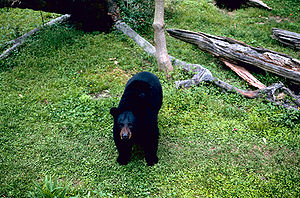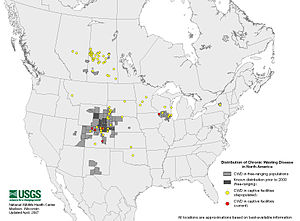 Image via Wikipedia
Image via Wikipedia
Cover scents used by deer hunters and other intriguing smells can
overcome bears’ natural shyness and bring them too close for comfort.
SEYMOUR, Mo.—Daron Wilkins wasn’t looking for a close encounter with a black bear when he climbed into a tree stand on Nov. 2, 2010, but he got one. Good luck allowed him and the bear to escape unharmed, but the Missouri Department of Conservation (MDC) says hunters don’t have to rely on fate to determine the outcome of bear encounters.
Wilkins was hunting on private land, sitting in a 20-foot ladder stand near the edge of a field. The oak flats surrounding the field had patches of dense underbrush and blackberry thickets. He first spied the bear around 5 p.m.
“She came out of the woods about 75 yards to my right,” Wilkins recalls. “She went back in the woods after a minute or so, and I kind of assumed she had winded me and had gone away. Probably 20 minutes later she came back out in the field.”
Wilkins, who hosts the Wild Idea Outdoors show on 98.7 FM, a sports talk-radio station in Springfield, carries a hand-held video camera when he hunts, so he started filming the bear.
“She was just browsing around in front of me. Every once in a while she would stop and dig around and then move on. Over the next few minutes she browsed her way to within 30 yards of my tree stand. All of a sudden she paused and stuck her nose in the air and turned right toward me.”
Following an intriguing scent, the bear moved without hesitation to the base of the tree where Wilkins sat.
“I had no idea how fast a bear can climb. Before I knew it, she was at my feet. I don’t think she had any idea I was in the tree. She got to the foot part of my stand, where she couldn’t go any further. Then she went around to the back side of the tree and continued coming up.”
Up until that moment, Wilkins had felt nothing but excitement at seeing a bear close-up. When he found himself within an arm’s length of the animal, another emotion washed over him.
“I was actually still trying to film her at the time. I leaned over the back side of the tree, and about then a light bulb went off in my head. ‘Are you going to let this thing climb up in the tree stand with you? You better get rid of it.’”
What Wilkins did next probably wasn’t the best thing, but it worked.
“I didn’t know what to do, so I just leaned over at her and went “Naaaah!” like a doe bleating. She stopped and looked at me. At this point, she was about two feet below me. We were looking eye-to-eye at one another. I figured it was going to be flight or fight. I’m either going to startle her to the point where she takes a swipe at me, or she’s going to leave. Thankfully, she decided to leave.”
The bear backed down the tree and departed, leaving Wilkins shaken.
“I realized the danger I had been in. My hands were shaking from sheer adrenalin. It was probably 15 or 20 minutes before I calmed down enough to hold my video camera steady and speak clearly enough to describe what had just happened.”
Video of the bear’s approach and Wilkins’ reaction is available atyoutube.com/watch?v=Q0KI8dhLd8w. After viewing the video and discussing the incident with Wilkins, MDC Resource Scientist Jeff Beringer identified several themes that reoccur in many hunter-bear encounters throughout the eastern United States.
One is the fact that Wilkins was using a deer attractant scent based on doe urine. Another is that he was wearing camouflage clothing. And the bear was young, probably two years old. In spite of its keen sense of smell, it didn’t seem to notice Wilkins’ scent. It retreated as soon as it became aware of Wilkins’ presence.
“Encounters like this one aren’t what I would call common in Missouri yet,” said Beringer, “but they are going to become more common as our bear population grows. We had another, very similar event in the past week over by Ellington. Biologists in states where they have well-established bear populations tell me this sort of thing is not uncommon there.”
Beringer said black bears rely primarily on their sense of smell to find food. They are totally focused on food at this time of year and forage practically nonstop. Although acorns make up the bulk of their autumn diet, they will investigate anything that smells interesting.
Other factors likely were at work in the recent encounters as well. Bears are at the top of the food chain and don’t expect to encounter danger in the woods. Hunters begin visiting areas that bears have had to themselves throughout the summer. Young bears that have little or no experience with humans don’t always flee at the first hint of human presence as older bears generally do.
“You’ve got a hunter who is basically invisible and smells like a deer,” said Beringer. “All a young bear is thinking about is food, unless something flips the switch in its brain that says, ‘Danger!’ It’s up to hunters to flip that switch before things get out of hand.”
Looking back on his brush with the bear, Wilkins says he would do things differently the second time around.
“That bear moved so fast, the only chance I had to stop her was when she was in the field foraging. When she smelled something, her behavior went from one thing to something completely different. In a matter of seconds, I went from ‘Hey, this is cool’ to ‘She’s in the tree with me!” If I had it to do over, I would yell at her when she was still way out in the field.”
Shouting is a good idea, according to Beringer. So is waving your arms, banging on the metal of your tree stand or making other loud noises. He advises hunters to remain standing during a bear encounter so they look as large as possible, and make and maintain eye contact with the bear.
“Staring at another animal is aggressive, predatory behavior,” said Beringer. “You want a bear to know you are there, and you want it to see you as a threat.”
Beringer said advice about how to act during a bear encounter is different if you surprise a bear at close range. Hunters or hikers who suddenly come upon a bear with food or cubs or where the bear has no place to run should speak in a calm voice and back away slowly. Never run from a bear, he says. That is prey behavior.
The great majority of Missouri’s bears live south of Interstate 44. MDC studies have identified hubs of bear activity around Webster, Howell and Shannon counties. Bear numbers drop off sharply where the typical, wooded Ozarks landscape gives way to prairie in southwestern Missouri and to the intensively farmed landscape of extreme southeastern Missouri.
Availability of seasonal foods, such as berries and nuts can draw bears to those food sources, making their behavior somewhat predictable. Persimmon trees, crop fields and food plots also can be bear attractors. In years when acorns are abundant, however, bears can be almost anywhere.
Beringer said bears have good memories, and they return periodically to places where they have found food in the past. He said hunters who use corn feeders to attract deer to their property have a better chance of encountering a bear, even if they stop feeding before the hunting season, as required by Missouri’s Wildlife Code.
Beringer said bears leave ample evidence of their presence in an area, especially this time of year. Consuming large amounts of acorns results in large piles of droppings – too large to be from anything smaller than a bear. If you find a large pile of dung that contains partially digested acorns, berries and other plant material, you can be fairly sure a bear has been there.
One thing hunters can do to minimize the likelihood of a bear approaching them is to keep any food they bring to the field in sealable plastic bags. Put left-over fruit peelings, apple cores, candy bar wrappers and other refuse back in the plastic bag to reduce enticing smells.
Beringer emphasized that bear encounters don’t have to be a bad thing.
“It’s kind of cool to see a bear,” he said, “and if you’re hunting, you don’t want to ruin your hunt by yelling. I can see where a person might be reluctant to make a bunch of commotion. But when a bear gets within 30 yards, that’s time to scare it off. Stand up and wave your arms. If the bear doesn’t see you and leave, you should shout and maybe throw things at it. If a bear gets uncomfortably close, it’s OK to shoot over it.”
One scenario that has occurred in other states, but not in Missouri as far as Beringer knows, is when a bear finds and claims a hunter-killed deer. Black bears can be very protective of a food bonanza the size of a deer carcass. Beringer said a hunter should not try to force the issue if a bear doesn’t immediately flee when approached.
“Bears are protected under the Wildlife Code,” he said. “It is not OK to shoot a bear that isn’t attacking you, and it isn’t smart to pressure a defensive bear. It’s better just to leave and come back later for the antlers, if it’s a buck.”
He said hunters who are concerned about bear encounters can carry pepper spray made especially for this purpose. He said however, that black bears – unlike grizzly bears–almost never attack people. Just because a bear moves toward you doesn’t mean it is aggressive. In most cases, it is merely curious and not aware that it is approaching a human.
Myron Means is the bear program coordinator for the Game and Fish Commission in Arkansas, which has had black bears since the 1950s. He said Arkansas has never recorded a bear attack on a hunter.
“Black bears that are involved in human attacks almost always are starving or in bad health,” said Beringer. “Our bears are healthy.”
In the extremely unlikely event that a bear does attack, Beringer says a hunter should shoot it. “We’re not trying to protect those kinds of animals,” he said.
If shooting isn’t an option, Beringer said you should always fight back, kicking or clubbing with a bow, a stick or any object at hand. He said learning to live with bears is mostly a question of raising outdoors people’s awareness.
“Folks in states that have had black bears for many years don’t think much about it,” he said. “They aren’t scared of bears, because problems are so rare. People know bears are out there, and they know what to do if they see one.”
For more about black bears in Missouri, seemdc.mo.gov/node/3506.
-Jim Low-




















